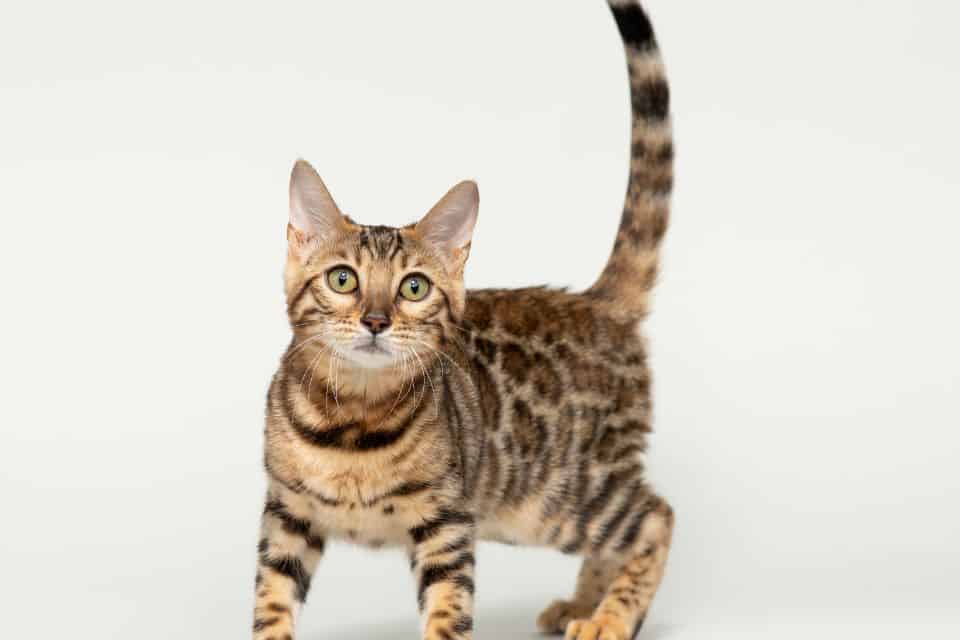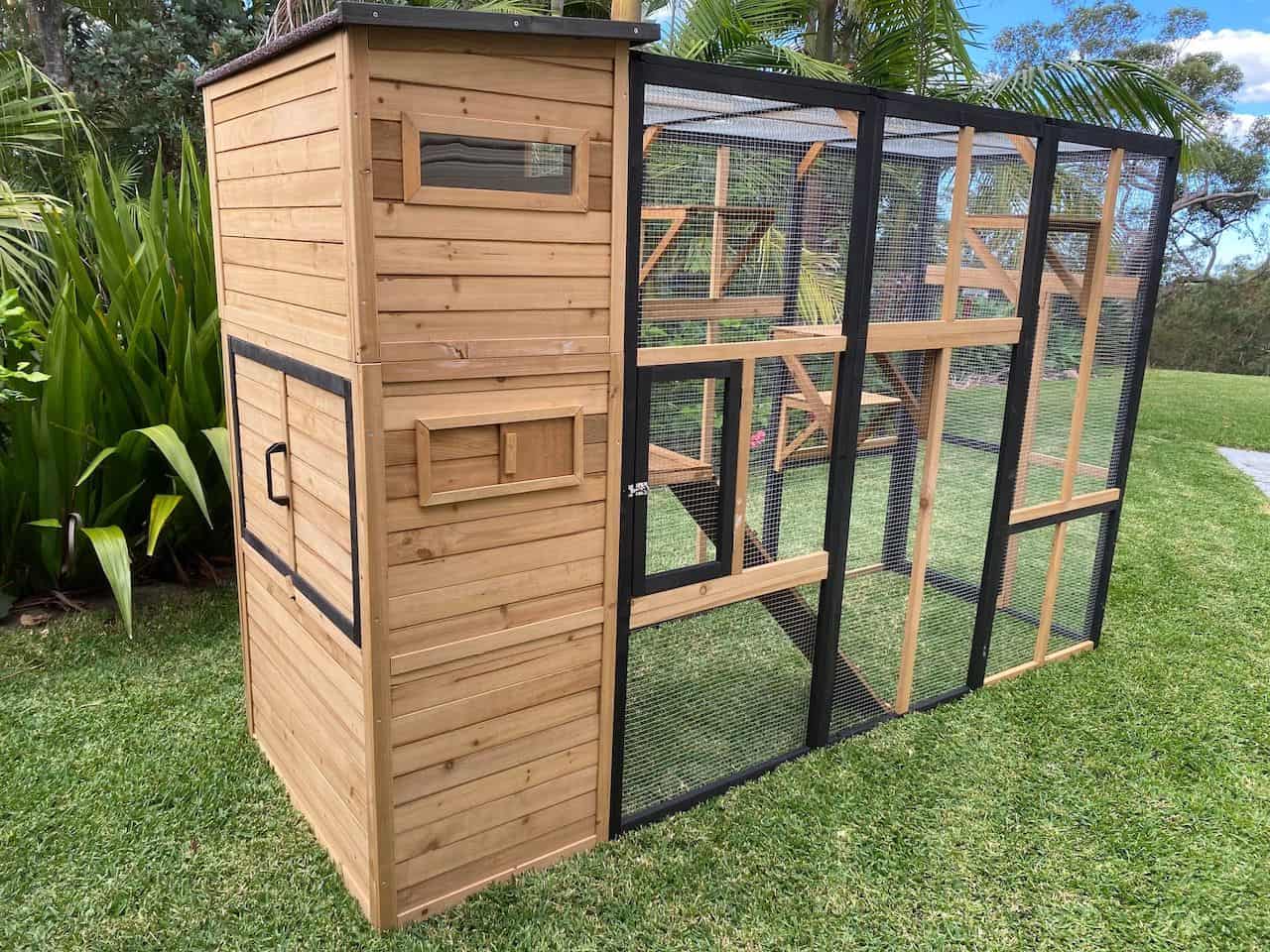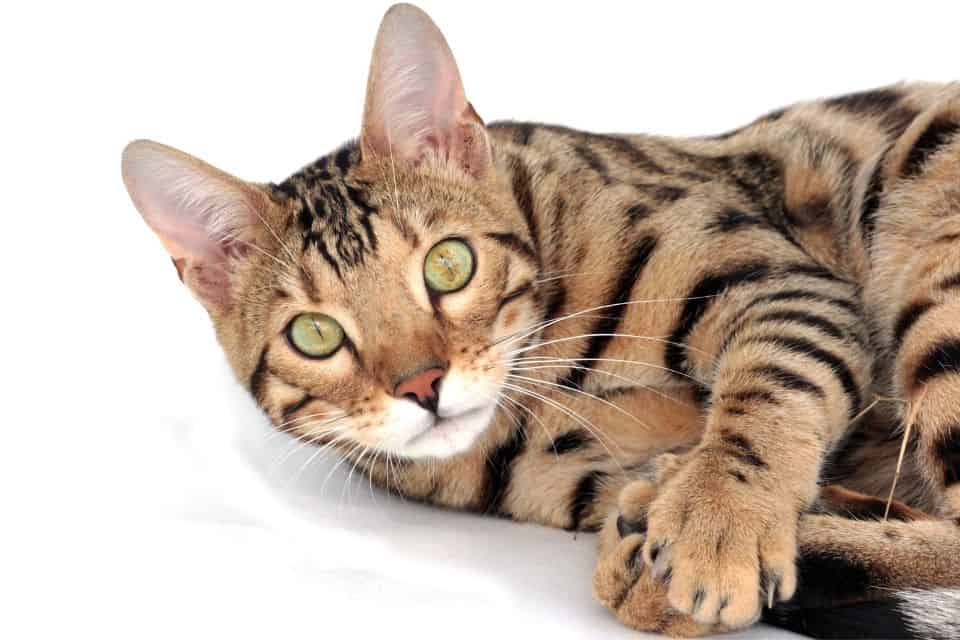Cats
Bengal Cats: Do They Make Good Pets?
Are Bengal cats the perfect pet for you? This recent breed of domestic cat is known for its wild markings and playful personality.
Here we’ll take a look at what makes Bengals unique, what you should know before bringing one into your home, and whether or not they make good pets.
Keep reading to learn more about these fascinating felines…
Bengal Cat History
Bengal cats are a relatively new breed of cat, having only been around since the late 20th century. However, their history is already quite fascinating.
The first Bengal cat was created in 1963 when Jean Sudgen in Arizona, USA bred her pet female Asian Leopard Cat with a black male domestic cat.
The Asian Leopard cat is a small wild cat, native to Southeast Asia. However, in the 1960s they were available in specialty pet stores in the USA.
In the 1990s, Bengal cats became officially recognised as a domestic cat breed and breeding programs were set up.
Since then, the breed has grown in popularity as both a pet and show cat. Owners are drawn in by their fun personality, beautiful coat and ‘wild’ heritage.
Appearance & Size
Bengal cats are most recognisable by their fur pattern, which makes them look more like a wild animal than a domestic cat. There are 3 patterns available – spotted, rosetted and marbled.
They also come in various colour options, including brown, silver, blue and charcoal. Their coat is short, low shedding and very soft to touch.
Bengals are a medium-large sized cat. They reach their full size at 18 months old. Females typically weigh 6.5kg and males weigh 8kg.
They are a little bigger than the average domestic short-haired cat found in Australia. However, there are plenty of household cat breeds that are much larger (such as Maine Coons or Ragdolls).
Bengals have muscular bodies, long tails and almond shaped eyes.
Personality
Bengal cats are highly intelligent and curious, which means they require a lot of mental stimulation each day to stay happy.
They’re also quite energetic, so they need daily exercise to help wear them out and prevent destructive behaviour.
Mental stimulation and exercise could involve interacting with humans or other pets, taking them for walks, allowing them time outdoors in a tall cat enclosure, playing with toys, or climbing a cat scratching post.
Bengals are affectionate and will bond strongly with one owner. They love to curl up next to you on the couch at the end of a long day or follow you around from room to room.
This loyalty, combined with their intelligence, means they can be trained to do basic tricks such as fetching a toy or sitting on command.
Bengal Cats Enclosures
Bengal cats are recommended to either live indoors or in an outdoor cat enclosure.
An outdoor enclosure allows your cat to enjoy time outside in the sunshine and fresh hair. This helps to keep your bored Bengal entertained, as they jump, climb and watch the birds fly by.
An enclosure protects your precious Bengal from getting lost, stolen or injured. It also lessens their risk of being exposed to harmful ticks and fleas, saving you money in vet bills.
Another huge benefit of cat enclosures if they protect native wildlife from your Bengal, who has strong hunting instincts.
The Greta Cat House and Stacey Cat Enclosure are great options for curious Bengals. They both have multiple shelves for your cat to jump up high onto and watch over their backyard kingdom.
Bengals are a very clean breed so you will need to keep their enclosure tidy for them.
If you decide to have your Bengal live inside your house instead, you will need to cat proof your home to the extreme. Intelligent Bengals will be able to open drawers and cupboards, accessing food they shouldn’t eat or causing damage to your property.
You will also need to set up a cat scratching post indoors so your Bengal doesn’t climb your cabinets and scratch up your expensive furniture.
Bengal Cats as Pets
If you are considering adding a Bengal cat to your family, there are a few things you should know about caring for them.
Bengal cats make wonderful pets, but they are not suitable for everyone. Their highly intelligent and energetic nature means you will have to commit to spending time with them and providing both mental and physical stimulation to keep them happy.
If you don’t, they may steal things, learn to open cupboard handles, scratch up furniture or destroy house plants just for some entertainment.
This means they are usually better suited to young, energetic families. If you are after a snoozy lap cat, a Bengal is not for you!
Bengals have a low shedding coat and require very little grooming.
Your pet Bengal should be fed a high protein, meat-based diet. High quality commercial cat foods are suitable. Limit treats to avoid obesity and related health risks. It is also important to give them access to fresh water at all times.
Owners report that Bengals can be difficult to litter train.
While they are intelligent and understand what the litter box is for, they stubbornly choose to toilet somewhere else. This is most commonly because their litterbox is dirty, they are bored or they want to mark their territory.
Buying a Bengal Kitten
Buying a Bengal kitten can be an exciting process. But there are a few things you should keep in mind to avoid being scammed and to ensure you’re getting a healthy kitten from a reputable breeder.
First, do your research. There are many unscrupulous breeders out there, so you want to make sure you’re dealing with a reputable one. Search online for reviews of breeders.
Once you’ve found a breeder you’re interested in working with, ask lots of questions. Find out how long they have been breeding Bengals, where they get their cats from, what type of health screenings they perform on their animals, etc.
A good breeder will be happy to answer all your questions and will also have questions for you to make sure you’re prepared to provide a good home for one of their kittens.
Next, be prepared to pay. Bengals are not cheap cats – they can range in price from $800-$2,500 AUD. Price will vary depending on demand, age, sex, show status and if they are desexed.
While this may seem like a lot of money, keep in mind that you are paying for a pedigree cat with years of work by the breeder to produce healthy, beautiful kittens.
If someone is trying to sell you a Bengal kitten for significantly less than the going rate, be very wary! It may be scam – they may be selling you a lower quality tabby cat or may not even have any kittens at all.
Finally, when meeting the breeder and seeing the kittens for the first time, take your time and trust your instincts. If something feels “off”, walk away.
A good breeder will have nothing to hide and will be happy for you to take your time making sure you have found the perfect kitten for your family.
Buying a Bengal kitten can be an exciting and rewarding experience – just be sure to do your homework first.
FAQ
Do Bengal cats make great pets for the right people?
Bengals are loyal and will bond strongly with people who spend a lot of time with them. Once bonded, they provide unconditional love. They will follow you around the house and want to play – like a puppy. Having a Bengal best friend can be very entertaining!
They also have minimal grooming requirements.
However, Bengals are highly energetic and intelligent. If you do not commit enough time to entertaining them and giving them attention, they can become destructive.
They are not suitable for owners seeking a quiet lap cat.
Do Bengal cats have a lot of energy?
Bengal cats are naturally energetic. They need daily exercise and stimulation to both mentally and physically wear them out.
Provide your pet Bengal with toys, puzzle feeders and scratching posts to entertain it while you are not home.
When you are home, interact with your cat often. Talk to it, play with it, and involve it in what you are doing around the house.
If you do not entertain your hyperactive Bengal and channel its energy into something positive, it may destroy your house as a form of entertainment.
Do Bengal cats get lonely?
Bengals are a social and affectionate breed. This means they can feel sad or stressed out when left alone for long periods.
If you are away for long hours every day for work, you may need to organise for a cat sitter to visit and spend time with your Bengal. Alternatively, you could buy a second cat to keep your Bengal company.
If your Bengal is lonely and not getting enough attention, it may begin to act out (just like a toddler would).
Do Bengal cats get along with children and other pets?
Bengals are suitable for families with children. Their wild heritage does not make modern Bengals any more aggressive than your average domestic housecat.
Teach your children to be gentle with animals and supervise your Bengal when it is around small children. While the breed is very even-tempered, you never know when playing together could suddenly turn too rough. Better safe than sorry!
Bengals are also suitable for homes with existing cats or other pets. Most Bengals will enjoy having the company and someone to play with them.
Always introduce pets to one another slowly and supervise them at first to ensure they are getting along.
Can you walk a Bengal cat on a leash?
Bengals can be trained to walk on a leash, like a dog. This is great as it can help to wear out your energetic cat and improve their mood.
Always attach a leash to a harness that is especially designed for cats and fitted correctly. Never attach a leash directly to a collar around your cat’s neck, as this can cause injury.
It is recommended you start leash-training your Bengal from a young age. Adult cats can be stubborn and are less likely to adapt.
When first training, just put the harness on within your house. When your cat reacts positively to the harness, praise it and give it treats.
Once it feels comfortable with the harness, then introduce the leash. Walk it around your living room until it gets used to it. Then it is ready to walk outside!
Remember that cats are smaller than dogs so will only need short walks.
Do Bengal cats like the water?
Unlike most other domestic cat breeds, Bengals love water. They love swimming, splashing around and drinking straight from taps.
Buy your pet Bengal a small inflatable kids swimming pool and it will have hours of fun splashing around in the water. Even a bowl of water will give it some entertainment.
Always keep your toilet lid closed as your Bengal may learn to flush the toilet and play around in the water. You will also need to have cat-proof knobs on all your taps throughout your house.
If your taps only need to be flicked up and down to work, your curious Bengal may learn to turn on the water and flood your bathroom.













Many people fall in love with the look of a purebred cat without taking into account the cat’s temperament or special needs. Bengal cats, for example, are very high-energy and need lots of exercise, while Persians need daily grooming.
Thank you for the article. The NFL Ravens just beat the Bengals. I wasn’t sure what a Bengal was. Now I think I know everything about a Bengal. Great job!